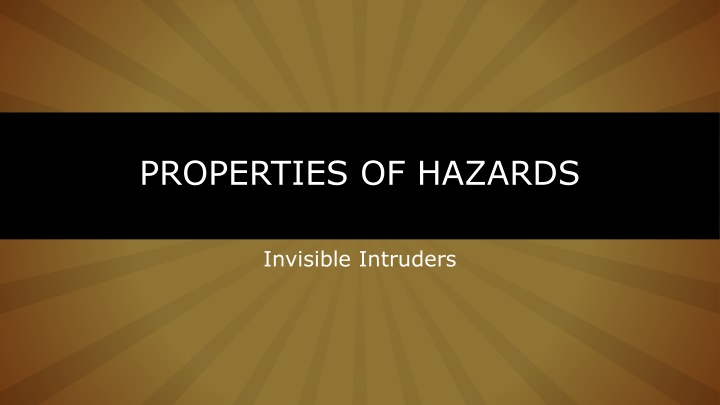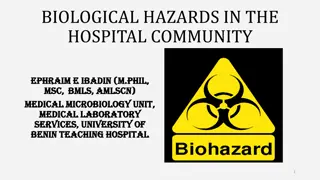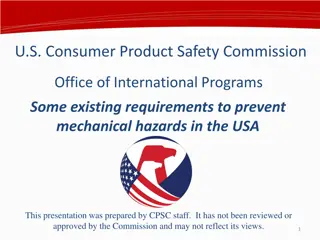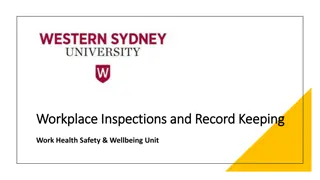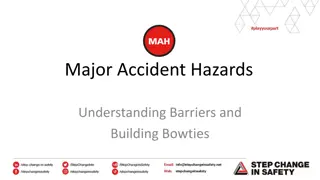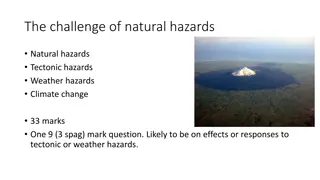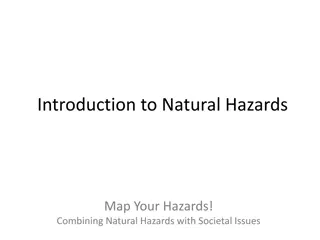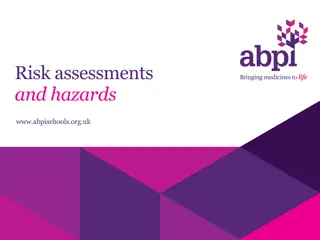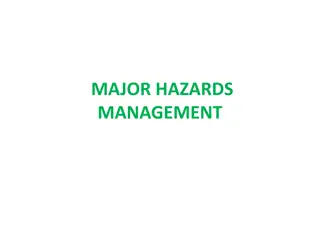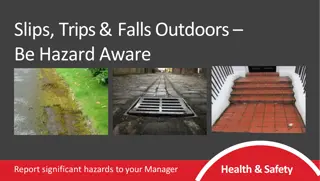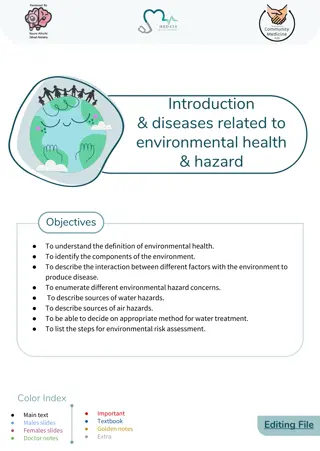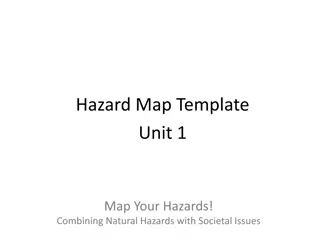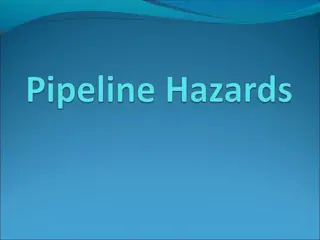PROPERTIES OF HAZARDS
"Learn about infectious microorganisms such as bacteria, fungi, and protozoa, along with viruses, their modes of transmission, and effects on the body. Explore the different types of microorganisms in this informative lesson."
Download Presentation

Please find below an Image/Link to download the presentation.
The content on the website is provided AS IS for your information and personal use only. It may not be sold, licensed, or shared on other websites without obtaining consent from the author.If you encounter any issues during the download, it is possible that the publisher has removed the file from their server.
You are allowed to download the files provided on this website for personal or commercial use, subject to the condition that they are used lawfully. All files are the property of their respective owners.
The content on the website is provided AS IS for your information and personal use only. It may not be sold, licensed, or shared on other websites without obtaining consent from the author.
E N D
Presentation Transcript
PROPERTIES OF HAZARDS Invisible Intruders
NAVIGATION TABLE Properties of Hazards: Invisible Invaders Introduction Pre-Test Lesson Post-Test Glossary
Introduction Invisible Invaders INTRODUCTION
Introduction Invisible Invaders Infectious microorganisms are organisms such as bacteria, fungi, and protozoa, that survive in certain environments, have ways to infect, and can multiply. Viruses are non-living infectious agents that are also capable of causing diseases in other organisms. They can enter your body through breathing, food, water, air, sexual contact, skin-to-skin contact, or blood transfusion.
Introduction Invisible Invaders These agents produce reactions or disease in the body. Some agents produce severe illness in the body while others produce a mild one. Some agents produce toxins when they grow in food and these toxins cause illness. In this lesson you will learn about different types of microorganisms and their properties.
Introduction Invisible Invaders OBJECTIVES By the end of this lesson, you should be able to: Identify which microorganism causes what disease. Identify modes of transmission of these microorganisms. Describe the main properties of these microorganisms.
Pre-Test Invisible Invaders PRE-TEST Click here for Google Forms Pre-Test
Lesson Invisible Invaders LESSON
Lesson Invisible Invaders All infectious agents (viruses, bacteria, protozoa and fungi) have the ability to reproduce, survive in the environment, to be transmitted to their hosts, to survive host defenses and to cause disease.
Lesson Invisible Invaders The diagram shown below illustrates the common life cycle of infectious agents, each having different durations for their periods of latency, incubation and communicability. Latent Period (latency) The time from initial infection until the start of infectiousness. Incubation Period The time from the initial infection until the onset of clinical symptoms. Period of communicability The period during which an individual is infectious and can spread to other hosts.
Lesson Invisible Invaders While different infectious microorganisms share certain common characteristics there are far more differences than there are similarities. types of infectious agents increases our ability to protect ourselves from infection and to recover from infections that do occur. Understanding the differences between the various
Lesson Invisible Invaders VIRUS A virus is not an independently living organism and can only reproduce by infecting a host cell. Viruses are very small in size, so small that they can only be seen with an electron microscope. They contain mostly only genetic material, either DNA or RNA. A virus has to enter a cell to survive and reproduce itself. Viral infections cause a variety of diseases. common viruses and their properties. Listed on the following slides are some of the most
Lesson Invisible Invaders VIRUS Agent Varicella - Zoster Virus Varicella - Zoster Virus Disease Chickenpox Symptom Transmission Skin to skin or respiratory contact. Incubation Period 2 - 3 weeks Itchy rash, which then forms blisters that dry and become scabs in 4-5 days. Starts with pain, fever, malaise, chills, gastrointestinal distress, and/or headache , within 5 days, develop swelling or redness of the skin and clusters of clear vesicles, which soon develop into blisters. Eyes or skin may turn yellow, Loss of appetite, Nausea. Vomiting, fever, stomach or joint pain, tiredness and this can lead to lifelong infection, cirrhosis (scarring) of the liver, liver cancer, liver failure, and death. Shingles Skin to skin or respiratory contact. 13 17 days Hepatitis B Virus Hepatitis B Body fluids of an infected person(blood to blood or sexual contact or sharing needles. Mother to newborn 7 26 weeks
Lesson Invisible Invaders VIRUS Agent Disease Symptom Transmission Incubation Period 10 14 days Paramyxovirus Measles Itchy rash, which then forms blisters that dry and become scabs in 4-5 days. Loss of immunity to fight infections, rapid weight loss, dry cough, recurring fever or profuse night sweats, fatigue, swollen lymph glands in the armpits, groin, or neck, diarrhea lasting more than a week, white spots or unusual blemishes on the tongue, in the mouth, or in the throat, pneumonia, red, brown, pink, or purplish blotches on or under the skin or inside the mouth, nose, or eyelids, memory loss, depression, and other neurological disorders. Skin to skin or respiratory contact. Body fluids of an infected person (blood to blood or sexual contact or sharing needles.) Mother to newborn HIV (human immunodeficiency virus) AIDS (acquired immune deficiency syndrome) 2 months 10 years
Lesson Invisible Invaders VIRUS Agent Disease Symptom Transmission Incubation Period 1 3 days Influenza Virus Influenza Typical illness includes fever and respiratory symptoms, such as cough, sore throat, runny or stuffy nose, as well as headache, muscle aches, and extreme fatigue. Wide range of symptoms ranging from mild symptoms to severe illness. These include fever or chills, cough, shortness of breath or difficulty breathing, fatigue, muscle or body aches, headache, new loss of taste or smell, sore throat, congestion or runny nose, nausea or vomiting, diarrhea. Respiratory droplets or direct contact with mucus SARS-CoV-2 Coronavirus that caused the COVID-19 Pandemic Respiratory droplets 2 14 days
Lesson Invisible Invaders BACTERIA Bacteria live almost anywhere imaginable, from inside your intestines to the bottom of the ocean floor. Of the thousands of types of bacteria, only a small fraction causes disease. In fact, there are many bacteria that are not only beneficial to humans but also some that are critical to our survival! This is especially true for certain bacteria in the gut.
Lesson Invisible Invaders BACTERIA In this part of our lesson on infectious organisms we will look at how bacteria differ, not only in their structure, but also in the role they play in our environment.
Lesson Invisible Invaders BACTERIA BACTERIAL CELL STRUCTURE While not all bacteria share the same rod-like shape of the model pictured here, they all have similar structures. At the center of the cell is usually a single chromosome. Like the DNA or RNA in animal or human cells, the bacterial chromosome has full capability to replicate itself. Unlike higher organisms, the bacteria's chromosome is not protected from the cytoplasm (fluid of the cell) by a nuclear membrane (such as in the nucleus of a protozoan).
Lesson Invisible Invaders BACTERIA BACTERIAL CELL STRUCTURE Also, bacteria may have extra pieces of DNA (called plasmids), as well as ribosomes (they help the chromosome replicate) in the cytoplasm. Plasmids confer certain advantages on their host bacterium. These may include genes for resistance to antibiotics. Plasmids also have a DNA sequence that triggers replication of the plasmid independently of the replication of the main DNA in the chromosome. Genetic engineering techniques often insert foreign DNA into bacteria in the form of plasmids, which then multiply in the bacterium. Lastly, some bacterial species have flagella to help them move around. Other species may have a rugged cell wall outside the delicate cell membrane.
Lesson Invisible Invaders BACTERIA PATHOGENIC BACTERIA Pathogenic bacteria release chemicals called toxins and are capable of causing disease. Toxins are classified as either endotoxins or exotoxins. Endotoxins produce toxic substances which are stored in their cell walls and released when the bacterial cells are lysed (broken open). Endotoxins produce localized effects, are less toxic than exotoxins and are not destroyed by heat. Exotoxins excrete toxic proteins which are usually the result of bacterial metabolism. Exotoxins produce systemic, potent effects and are usually heat-sensitive.
Lesson Invisible Invaders BACTERIA PATHOGENIC BACTERIA Antibiotics, typically found in molds, can kill bacteria. But in an infection, there may be a small fraction of bacteria with DNA codes that make them resistant to the antibiotic. If such bacteria are not killed by the antibiotic and the natural immune mechanisms, they may come to take over the infection and make the patient untreatable. Taking antibiotics for less than the prescribed number of doses is dangerous because there is a good chance that only antibiotic-resistant bacteria will remain alive. Without having to compete with non-pathogenic bacteria and non-resistant bacteria, antibiotic-resistant bacteria will then become very difficult to eliminate. Not all bacteria cause disease. Many bacteria help prevent disease by competing with pathogenic bacteria.
Lesson Invisible Invaders PROTOZOA Protozoa are single-celled microorganisms. While many protozoa benefit man by feeding on bacteria, others are parasitic to humans and animals and cause serious diseases. Protozoa are more complex than bacteria. The genetic material (contained in chromosomes) of protozoa is separated from the cell fluid (cytoplasm) by a double membrane layer. Also, the cytoplasm of protozoa is more highly organized, similar to the situation in animal cells.
Lesson Invisible Invaders PROTOZOA There are many sources of infection from parasitic protozoa. Sources of infection include, but are not limited to, contaminated food or water, infected animals or insect bites. In this part of our lesson on infectious agents, we will discuss some common parasitic protozoa and how to protect yourself from infection. A few examples of harmful protozoa are listed on the following tables along with the symptoms they cause and how to prevent becoming infected.
Lesson Invisible Invaders PROTOZOA Protozoan Cryptosporidium parvum Symptoms Prevention Diarrhea. May also cause vomiting, headache, fever and stomach cramps. Can be fatal to those in poor health. Use an approved water filter, an approved brand of bottled water or boil water for 1 minute. Avoid drinking water from lakes and rivers. Spread by mosquito bites. The use of DDT in the U.S. and many other countries brought malaria under control. It is still a problem in many Third World countries though. Thoroughly cook all meats, be careful handling cat litter, feed cats commercial cat food, cover sand boxes when not in use and wash all fruits and vegetables before eating. Plasmodium (causes malaria) Fever, headache and vomiting. Can be fatal. Toxoplasma gondii Does not cause symptoms in most people. Can cause fatalities in unborn children and in AIDS patients.
Lesson Invisible Invaders FUNGI Do you know that yeast and mold are actually types of fungi? Fungi can be found in almost any environment, indoors or outdoors, and growth is stimulated by warm and humid conditions. There are many different types of fungi, some more toxic than others. Even though most molds are hazardous to humans, they serve an important role in nature. Molds help break down dead material found in soil, foods, plants and other items while some yeasts can help with baking.
Lesson Invisible Invaders FUNGI Cheese BENEFICIAL FUNGI Even though molds are generally bad for us, there are a few ways to use mold to our benefit. The blue-green spots on the blue cheese pictured is mold. Believe it or not, the mold is supposed to be there. Penicillium mold is injected into blue cheese during its production to give it its unique flavor and as a side affect, an unusual stench. Penicillium mold is a blue-green mold that is commonly found on moldy bread. This mold was the first to be found to contain an antibiotic (penicillin).
Lesson Invisible Invaders FUNGI Antibiotics BENEFICIAL FUNGI Antibiotics are agents that kill bacteria. In 1928 bacteriologist Alexander Flemming discovered that penicillium mold actually killed some species of bacteria. A few years after Alexander Flemming's discovery penicillium was being marketed as penicillin, a common anti-bacterial drug that has helped save many people's lives. Most other antibiotics used by physicians were discovered from other species of mold. Can you guess why it is so common for fungi to produce antibiotics? Think about their survival in nature and what they compete with for nutrient sources.
Lesson Invisible Invaders FUNGI Baking BENEFICIAL FUNGI Yeast is very important in the area of baking. Yeast is added when making almost any bakery product to make it rise. Without yeast our bread, cakes, muffins, biscuits and other bakery products would be solid heavy slabs. (Yeast is also used in the production of beer and whiskey).
Lesson Invisible Invaders FUNGI Mushrooms BENEFICIAL FUNGI The delicious fungi, mushrooms, are a part of many people's diets. Only certain types of mushrooms are edible and some people don't find them quite as tasty as others.
Lesson Invisible Invaders FUNGI Mold in homes is a major problem, especially in humid climates. Leaky pipes, floods, or any other source of moister are great places for mold to grow. Many people are unaware that they have mold in their homes and some people aren't aware of the hazardous effects that it could have on their health. HOUSEHOLD MOLD
Lesson Invisible Invaders FUNGI HOUSEHOLD MOLD Household molds can be almost any color but the most common are grey or black. Tiny particles known as spores are present in the air at all times and if they settle on the proper nutrients they can germinate. Such nutrients can include: Soil Plants (alive or dead) Foods Fabrics Paper Wood Many other materials
Lesson Invisible Invaders FUNGI Mold is harmful to the material it grows on. It can lead to stains, discolorations, weak and rotten wood, damaged or destroyed fabrics, and even foul odors. If the moldy area is large enough it could produce enough airborne irritants to cause adverse health effects. HOUSEHOLD MOLD Cosmetic Damage
Lesson Invisible Invaders FUNGI Tiny particles of mold can float around in the air and be inhaled. Sometimes simple skin contact or ingestion is enough to induce a reaction. The most common symptoms of mold exposure are allergy-like: Stuffy nose Congestion Wheezing cough Breathing difficulties / shortness of breath Sore throat Skin and eye irritation Upper respiratory infections (including sinus) Some people are extremely sensitive to mold and can have more severe reactions and may even develop mold in their lungs. However, mold is very rarely life-threatening. HOUSEHOLD MOLD Affects of Exposure
Lesson Invisible Invaders FUNGI There are two main structures of fungi: septate and aseptate. Septate fungi are more advanced and separated into smaller sections by a septum membrane. Aseptate fungi are more primitive and do not contain septum or separate sections. STRUCTURE
Lesson Invisible Invaders FUNGI Fungi can take many different shapes and sizes but they normally follow this basic structure. Hyphae are individual thread-like filaments that intertwine to form a web-like structure called a mycelium. Certain hyphae can produce reproductive spores by budding off at the ends. That is how fungi can travel through the air and find their way to many different surfaces. Most hyphae are 2-10 micrometers across but some are nearly 300 micrometers across. Just to give you an idea of the size of a micrometer, a human hair is about 100 micrometers across. This means that a person can't see hyphae with the naked eye. STRUCTURE
Lesson Invisible Invaders FUNGI Athlete's Foot (tinea pedis) is caused by a fungus. It can occur in individuals whose feet are damp or sweaty. It affects the soles of the feet and areas between the toes. Swimming pools, locker rooms, and showers are easy places to get athletes foot because they provide damp environments where people walk around barefoot. The hyphae of tinea pedis dig into the skin (normally between the toes) where they get their nutrients. INTERESTING FACT
Lesson Invisible Invaders FUNGI To cure athlete s foot antifungal medicine can be purchased at most stores and used daily for a few weeks. The fungus and symptoms might appear gone after a few days but can come back again if treatment isn't performed for the full amount of time. INTERESTING FACT Learn More: https://kidshealth.org/en/teens/athletes-foot.html
Lesson Invisible Invaders FUNGI Fungi can reproduce either sexually or asexually. Both ways of reproduction use tiny budding bodies called spores. These spores form at the end of certain hyphae in a ball- like sac called a sporangium. When mature the sporangium open and release the spores. The spores are tiny particles that float around in the air and are incased in a protective coating that can survive extremely hostile environments. When they land on the appropriate nutrients they germinate, growing and expanding as long as the right conditions are present. SPORES Sporangia
Post-Test Invisible Invaders POST-TEST Click here for Google Forms Post-Test
Invisible Invaders GLOSSARY
Glossary Invisible Invaders GLOSSARY FOR A-F Antibiotics: Substance produced by bacteria and fungi to kill harmful germs. Return to Bacteria; Fungi Aseptate Fungi: Fungi structure that is more primitive and is not divided into separate sections. Return to Fungi Bacteria: Unicellular microorganism with cell walls that lack organelles and an organized nucleus that can cause disease. Return to Bacteria Chromosome: Structure of nucleic acids and proteins in the nucleus that contains genetic information. Return to Bacteria Endotoxin: A toxin that is present inside a bacterial cell that is released when the cell is destroyed. Return to Bacteria Exotoxin: A toxin secreted by a bacteria. Return to Bacteria Flagella: A threadlike structure that enables many protozoa and bacteria to swim. Return to Bacteria Fungi: Group of living organisms like yeasts, molds, or mushrooms. Return to Fungi
Glossary Invisible Invaders GLOSSARY FOR H-Pa Hyphae: Branching filament that will make up the mycelium of a fungus. Return to Fungi Incubation Period: Time from initial infection by a microorganism until the onset of clinical symptoms. Return to Lesson Latent Period (Latency): Time from initial infection by a microorganism until the start of infectiousness. Return to Lesson Micrometer: A unit of measurement equal to 0.001 millimeters. Return to Fungi Microorganisms: A microscopic organism, like bacteria, protozoa, or fungi that can be capable of causing diseases. Return to Introduction Mold: Type of fungus that grows in the form of hyphae multicellular filaments. Return to Fungi Mycelium: A network of fungal threads or hyphae. Return to Fungi Pathogenic: Capable of causing disease. Return to Bacteria
Glossary Invisible Invaders GLOSSARY FOR Pe-V Penicillin: Group of antibacterial drugs that can attack a wide range of bacteria. Return to Fungi Period of Communicability: Time period where an individual is infectious and capable of spreading a disease. Return to Lesson Plasmid: Small circular DNA strand in the cytoplasm of bacteria or protozoa. Return to Bacteria Protozoa: Group of single-celled microorganisms that are more complex than bacteria. Return to Protozoa Ribosomes: Organelle made of RNA that is used to make proteins. Return to Bacteria Septate Fungi: Fungi structure that have hyphae divided into compartments called septa. Return to Fungi Spores: A reproductive unit of a fungi. Return to Fungi; Spores Virus: Infective agent that can cause a disease. Return to Viruses
